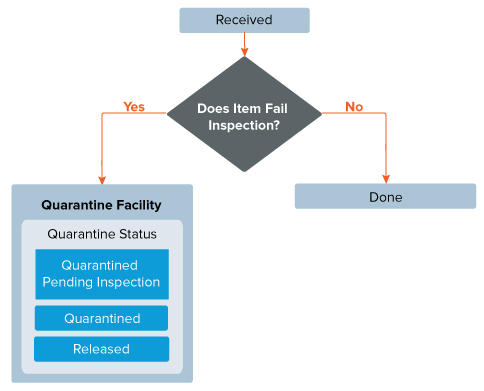An introduction to Netsuite Quality Management software solution
Video- Netsuite’s Quality Management
An inspection and specification are the aspects that define quality management processes. NetSuite defines a quality specification as a set of related inspection plans. Based on these inspections and specifications, the level of quality is determined by shop floor processes and incoming and outgoing shipments. Are the finished products in good condition, have the right number of products been shipped to the customer, or would it be beneficial to test the pH level of the finished product?
Using the NetSuite Quality SuiteApp, you can create new inspections and specifications based on changing standards and requirements. The Copy Existing feature lets you create new inspections and specifications by copying existing, similar inspections and specifications, which ensures that ongoing maintenance is less time-consuming.
To deliver the highest quality with minimal overhead, NetSuite Quality Management automates and formalizes quality policies, standards, and practices. Assure that standards are met throughout the production process by inspecting raw materials and conducting spot checks. Tests can be selected quickly and easily, parameters can be set to evaluate results and testing policies can be defined at receiving and during production. Whenever required, NetSuite automatically instructs inspectors where to test and when to test it, collects results, and carries out remediation workflows.
Features of Netsuite Quality Management
Businesses can meet customer and regulatory quality standards using NetSuite Quality Management. Templates and tools help associate collected data with other records and workflows to spot issues, such as a new vendor not meeting expectations.
1. Receiving and In-Process Inspections
An item can be tested on demand, upon receipt and during the manufacturing process. Having been defined, tests can be attached to an item or operation to ensure compliance with quality-control purposes. If a product fails an inspection, it can be put on hold for further processing.
- Enforce compliance to minimum quality standards
- Automatic prompting for inspection / test results
- Workflow based handling of non-conforming materials
2. Customizing Quality Management Workflows
With the Quality Management Suite App, you can model and execute quality non-conformance processes. Copy and configure NetSuite baseline or Quality Management workflows to create your own organizational workflows. Modeling and executing business processes related to quality non-conformance are supported by the Quality Management SuiteApp.
In the following sections, you can learn how to customize your Quality Management workflow:
i. The Quality Inspection Queue
ii. Quality Workflows
iii. Interpreting Status and Action
i. The Quality Inspection Queue
Quality Inspection Queue records represent triggered quality specifications. In the quality tablet list and the inspection queue suitelet, it is the primary record. This record type is monitored by all non-conformance workflows and triggered when its status or action changes.
The Status Field- The value of the Status field will be affected by the data collected during an inspection. Quality Managers can assign a value to the Status field in order to control the lifecycle. The following diagram illustrates the typical development of the Status field.
Those inspections that are in the Pending or In-Process state can be collected by the Status workflow. It is only possible for Quality Managers to manually transition to Hold or Cancel dotted lines.
An inspection’s Pass or Fail status is determined by the specification’s conformance rules once all quality data has been submitted.
The Action Field- NetSuite Quality Conformance Action list controls the values that can be assigned to the Action field. The baseline workflows are associated with the following values:
- Quarantine: The NetSuite workflow is prompted to stop using the item. The Quarantine workflow monitors inspections. SuiteFlow is used to perform a NetSuite Bin Transfer or Inventory Status Change to designate items as quarantined and then released.
- Return to Vendor: Starts the return-to-vendor process in NetSuite. This workflow monitors the inspection process. An item receipt return process that did not pass inspection is started with a custom SuiteFlow script based on a Vendor Return Authorization.
- New: add actions to the list to trigger workflows
ii. Quality Workflow
Quarantine Workflow
This workflow monitors inspections. By using a custom SuiteFlow script, it performs a NetSuite Bin Transfer or Inventory Status Change to designate items as quarantined, then release them.
SuiteFlow Configuration
The Quality Receipt Quarantine SuiteFlow script can be used in the following workflow states:
- Released
- Quarantined Pending Inspection
- Quarantined
Return to Vendor Workflow
It is responsible for monitoring inspection transitions. With the help of a custom SuiteFlow script, this workflow creates a Vendor Return Authorization that starts the item receipt return process that failed inspection.
iii. Interpreting status and action
With the Quality Management SuiteApp, certain combinations of Select and Action fields can trigger the baseline workflows. Here is a table that illustrates how the various combinations of inspections result in a workflow response.
| Action/Status | Pending | In-Process | Pass | Fail |
| Quarantine | Quarantine: pre-inspection quarantine | Quarantine: release if ready quarantine | Quarantine: post-inspection quarantine | |
| Return to Vendor | Return to Vendor: initiate return to vendor authorization |
3. Custom Quality Assurance Specifications
Quality Specifications
The NetSuite Quality Management module lets you assign specifications to items, vendors, and locations. Modules for inspection frequency and sampling are also available.
These quality specifications group inspections related to specific items and define the inspection scenarios. They may include default values or standards. Specifies form the basis for capturing quality data, creating reports, improving workflows, and identifying non-conformance. A quality specification formalizes policies and procedures, as well as nonconformance rules. A quarantine, a return merchandise authorization (RMA), or a downgrade, for example.
4. General Conformance & Quality Rules
NetSuite Quality Management helps ensure product quality by defining conformance rules. Error messages indicate where and why updates failed. In addition to workflow-driven non-conformance, this module provides tools such as quarantine, release and initiation of vendor return authorizations.
5. Test Definitions
With NetSuite, you can specify the type of inspection, the acceptable limits, the minimum qualifications of the inspector as well as the category and method of inspection from a master list of predefined profiles. With this system, businesses can enforce standards on inspector credentials, capture measurements, and compare data to pass/fail limits. Data elements that define the parameters of an inspection process can be set up for each inspection.
Key Benefits:
- Centrally managed list of tests / inspections
- Enforce minimum Inspector qualifications
- Capture measurements and compare to pass / fail limits
6. Data Collection
If you login as a Quality Administrator, Quality Engineer, or Quality Manager, the quality management tablet interface opens in write mode. The Administrator and Custom roles do not have write access to the tablet.
Mobile Data Collection
NetSuite’s tablet interface makes it easy to collect and process test data directly from the shop floor or receiving dock. Using the mobile collection interface, quality engineers can gather and analyze results efficiently and accurately. In addition to performing inspections, reviewing standards, recording results, and submitting data for analysis from the tablet, engineers can receive immediate feedback and access to test results directly from the work area.
- Intuitive User interface, interactive application
- Device agnostic—runs on any browser based tablet
- Real-time processing of inspection results
You can use the NetSuite Quality Management SuiteApp to record quality inspection data wirelessly within your facility using your mobile device. All specifications that are in the Pending or In Work status are summarized in the tablet Quality Specifications Queue table. Data can be reported for a Location, Specification, Transaction, Item, and Status.
7. Reporting
In the Quality SuiteApp, you can review the set up and the execution of your inspections by viewing two administrative reports. Reports appear in separate windows, so you can preview results to help refine your search.
SuiteApp will add operational reports in future releases that will allow you to quickly review quality data items, vendors, inspections, and other data related to quality standards and data collection.
Administrative Reports- The administrative reports help you monitor the inspection process, resolve errors quickly, and ensure that similar errors won’t occur in the future.
8. Specification Review
The specifications in many cases are complex, including various inspections, each with a different field, standard, and rule. The purpose of a specification review is to ensure that your organization’s quality needs are represented by providing a view of the underlying definition that helps examine the entire specification.
Summary
Small to medium sized businesses can automate quality management and regulatory compliance processes by using a cloud-based quality management system. A single application improves and gives real-time visibility and collaboration by managing quality processes, document control, and training.







